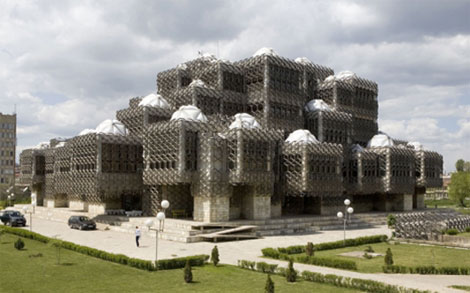
National Library, Prishtina
Prishtina is growing, and to hell with the consequences, even though urban planning and enforcement of building regulations have a very low priority. In order to accommodate the fast-growing population, vacant spots in the capital are being filled with apartment block in do-it-yourself architecture (concrete frames and big, red perforated masonry blocks), with space into a construction pit overnight, as happened with a bathhouse in the old Turkish area.
The fact that the National Library by Andrija Mutnjakovic (b.1929) still looks the way it did a quarter of a century ago is a miracle in the circumstances. Compared with the 1982 photo-graph that hangs in the architect’s studio in Zagreb, there are at most a few more apartment buildings in the background. The library, with its 73 small domes, was supposed to be the focal point of the complex of university buildings, but in an area where daily life during the 1980s came more and more to resemble a civil war, nothing came of these plans. Mutnjakovic’s masterwork stands in a sandy, litter-strewn expanse where stray dogs sleep in the tall grass. The surroundings merely serve to strengthen the overwhelming effect of the building, an architectural oasis in a concrete wasteland.
When Mutnjakovic was commissioned to design a library for the ex-Yugoslavian province, the tension between Albanian and Serbian Kosovars was already palpable. Looking for a unifying symbol, he came up with the cube and dome, common features of the Ottoman and Byzantine architectural styles that define the appearance of the region. When they looked at the library, Kosovars would be able to recognize the Turkish baths in Prizren and the Orthodox patriarchate in Peja(Pec). From above, the library looks like a motley cluster of cubes, varying in size and height, rather like a village. The domes supply even, natural light to the reading rooms. The cube shape contributes to the compactness and the sense of protection, which is further reinforced by the aluminum net of hexagons that is draped over the building.
At the opening in 1982, reactions from Serbian politicians were downright hostile, Mutnjakovic recalls. A quarter of a century and a civil war later, the rumour that the domes refer to the “PLIS”, the traditional egg-shaped Albanian head covering, is still doing the rounds, but now in the other camp and with a positive spin. Equally persistent is the misapprehension that the library was originally designed as a palace for a Kuwaiti sheik. It recently turned up in a new travel guide for the area. Whereas the Mutnjakovic’s building was actually intended as an “authentic national architectural expression” – as the architect put it in the original building plan. His regionalism was a reaction to the impersonality of the International Style and an attempt to combine function with regional traditions.
“Rural architecture with modern means”, is how he describes it now, a lesson he learned from Yugoslav predecessors like Nikola Dobrovic (1891-1969) , whose concrete coastal villas have Dalmatian roots, and his immediate teacher Drago Ibler (1894-1964).
By the time NATO intervened in 1999, Mutnjakovic’s library had become the commando headquarters of the Serbian army. Albanian students had already been denied entrance to the building years earlier. The library’s best times is still to come. In post-war Kosova, where Albanian Kosovars call the shots, the building has little competition in any race to become the new icon of the Nation.
Author: Werner Bossman – A10 #17 .[ad]
.


